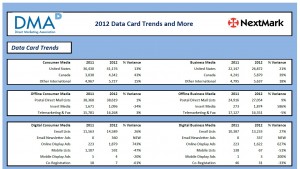[This post originally appeared in ClickZ.
It’s funny how people deride Microsoft for not being successful in advertising technology when 80% of digital media dollars are transacted using their media planning software. Despite the fact that we live in a world where computers can evaluate hundreds of individual bid requests on a single impression and render an ad serving decision in under 50 milliseconds, the overwhelming majority of display inventory is bought using e-mail and fax machines. Those media plans are manually created in Excel.
Terence Kawaja of the famous LUMAscape maps, which depict the 300-plus companies who enable the 20% of display buying that happens programmatically, once said that “inertia is the agency’s best friend” when asked why holding companies were not doing more to bring innovation to advertising. I imagine that part of what he meant was that their common business model (billable hours plus a negotiated margin) does not create an incentive for efficiency. On the contrary, complexity in media planning means more billable hours—as well as a built-in need for agencies’ existence. After all, if media buying were easy, then marketers would do it themselves.
A result of this inertia is the fact that Microsoft’s business products (Outlook, PowerPoint, and Excel) power the majority of digital media buying today. After research is done in platforms like Comscore and Nielsen, media planners output a spreadsheet, create an RFP, and begin the long process of gathering other spreadsheets from publishers. After a few weeks and $40,000 in hours spent cutting and pasting, a media plan is born. This grueling process has the average media planner spending more time on manual, repetitive processes than on strategy and high-value, client-facing activities. You would imagine that agencies would work quickly to adopt technologies that make the transactional nature of media planning more streamlined.
It seems like agencies don’t care, as long as they are getting paid for their work, but there are real problems with the Excel model. Here are a few to consider:
- Employee Happiness: One of the biggest problems facing agencies is the constant turnover in media planning departments. Agencies hire junior planners directly out of college in many cases, and work them long hours where they perform many of the manual processes that go into digital media plan execution. After a while, they take their training and insights and ascend the ladder into the next position, or take their newfound expertise to the next agency, where they can expect more of the same for a slight raise. Wouldn’t it be better to deploy technology that takes out the grunt work of campaign planning, and enables planners to focus on more high value activities, such as strategy? The costs of employee turnover are high, as are the hidden costs of employee dissatisfaction.
- More Bandwidth Equals More Clients: Although agencies get paid for their hours, there is a point at which an agency can only take on so many clients. After all, adding employees (even low cost ones) means adding more desk space, furniture, computers, and financial overhead in general. Eventually, an agency starts to need increases in productivity at the employee level in order to scale, and add more clients (and revenue) without overly expanding its physical footprint. Leveraging technology that streamlines the manual part of media planning means being able to do more planning with less planners, enabling shops to scale their market share without adding as many junior personnel.
- You Don’t Get Paid for Pitching: Digital media shops don’t always get paid for all of their hours. Pitching new clients means creating sample plans and putting company resources to work on speculative business, which is all the more reason to find efficiencies in media planning technology.
- Spreadsheets Don’t Learn: One of the biggest problems with digital media planning using manual, spreadsheet-driven processes is that it becomes hard to maintain a centralized knowledge base. Planners leave, plans get stored on disparate hard drives, information on pricing and vendors is fragmented, and it is hard to measure performance over time. Despite the fact that they are getting remunerated for their work, agencies must consider whether the method of using man hours to perform repetitive tasks could be more expensive in the long run. As David Kenny once remarked, “If you are using people to do the work of machines, you are already irrelevant.”
At the macro level, the cost-plus pricing model’s principle disadvantage is that it creates what economists call a perverse incentive or, put more simply, an incentive for inefficiency. When it that cost model is applied to digital media planning—already fraught with inefficiency—you have an environment ripe for disruption. The advent of new, platform-driven media planning and buying technologies is spawning a new era of “systematic guaranteed” buying which promises to streamline and centralize the way banner ads are bought today. Agencies will be able to dedicate more hours to client facing tasks and strategy, and publishers will be able to manage their transactional RFP business more seamlessly, and be able to focus their sales teams on super premium, high CPM sales.
By eliminating much of the human cost of media planning and buying, technology can help add more value to the media itself—the real “plus” that we have been looking for.



